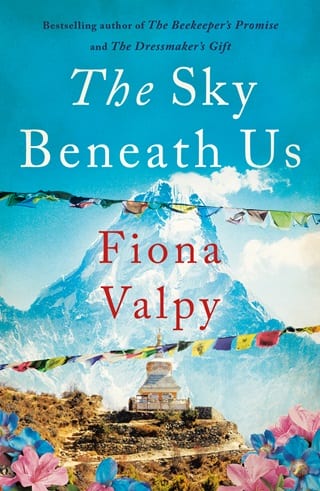Daisy: March 2020
The trek from Phakding to Namche Bazaar is a challenging one. We set off early, the porters shouldering our packs and heading off first, while I settle up what I owe the teahouse owner for my food and accommodation. To my relief it’s not very much and scarcely makes a dent in my wad of rupees.
Tashi Sherpa takes the lead and Sonam follows behind me, so I feel obliged to set off at a brisk pace, trying not to hold them up. Fairly soon, though, the path starts to climb, and my legs begin to feel as heavy as lead. We must be at over two and a half thousand metres now, although we have a climb of another eight hundred to do today. I do the sums in my head ... that’s more than two and a half thousand feet. Less than a Scottish Munro, I tell myself, and I’ve climbed a few of those in my time. But the air is thinner up here and my breathing is laboured, as if I’ve already climbed a mountain before we’ve begun.
As I begin to fall behind, the Sherpas slow their steps to match mine. The gentler pace helps me breathe a little more easily. ‘Just put one foot in front of the other, again and again, slowly, slowly, along the path,’ Tashi tells me, and his words become a mantra that I repeat over and over in my head. One foot in front of the other, again and again, slowly, slowly.
We walk through pine forests where more rhododendron flowers spill down the hillsides beneath us and silver strands of lichen, like greying hair, festoon the branches of the trees along the path. Tiny blue gentians, the colour and size of forget-me-nots, cling to the dusty earth and here and there the purple pom-poms of primulas emerge from the mat of dry grass that carpets the sides of the valley.
We cross flimsy-looking bridges spanning deep ravines, festooned with prayer flags that flutter in the wind. Every now and then we have to stand aside and wait for pack animals to cross, cumbersome loads of gas canisters and sacks of rice strapped to their backs.
After four hours, we reach a rocky riverbank and I sink down thankfully to rest. It’s only eleven o’clock but the sun – whose strength has been camouflaged by the cooling wind – burns through the sleeves of my top. My shoulders feel tight against the pull of the straps of my backpack. I gulp from my water bottle and then take in my surroundings. A gusting wind tosses the branches of the scrubby trees growing beside the river. The water is an extraordinary shade of milky turquoise, carrying finely ground debris from glaciers high up in the peaks towering above us. And from the Khumbu glacier itself, I suppose, where those Sherpas lost their lives in 2014.
I’m lost in my thoughts, picturing the icefall tumbling in frozen perpetuity from the mountainside, when Sonam nudges me and points upwards, into the distance. It takes me a moment to register what he’s saying.
‘There it is. The Hillary Bridge. The highest and longest one we’ll cross.’
Despite the water I’ve just drunk, my mouth feels dry as I focus on what looks like a fragile thread, suspended in thin air several hundred feet above us. If it weren’t for the prayer flags tied along their length, the wires of the bridge would hardly be visible against the dazzling blue sky beyond.
A helicopter swoops overhead, swinging right to follow the line of the valley. ‘Usually many more flights, taking supplies to Everest Base Camp,’ says Tashi. ‘But not now. Just a few. Bringing people out. Everyone leaving.’
I wish with all my heart I could hitch a lift and be transported effortlessly to our final destination of Phortse. But I know it’s important for my body to adapt slowly, acclimatising and avoiding the threat of altitude sickness, which can be a silent killer. A ride in a helicopter to the higher altitudes we’re aiming for could do more harm than good. So I get to my feet and take a deep breath, trying to fill my lungs with the thin air in preparation for climbing the long flight of steps leading up to the bridge.
As we approach it, I can’t help imagining the wires suspending the bridge snapping, the whole thing twisting from its fixing points and sending us tumbling into the abyss. Even close up, it still looks flimsy, made from just a few cables and some planks of wood. But Tashi and Sonam seem completely confident in the structure. And our porters have probably already walked across it, I remind myself, far more heavily laden than we are. My legs and lungs burn with each upwards step, but I trudge onwards, trying not to think about anything other than putting one foot in front of the other, until, at last, we’re standing at the start of the bridge.
The only sound is the rushing of the wind and the fluttering of the prayer flags streaming from the suspension wires. Then from behind us comes a soft clanking of bells and we have to stand aside to let a man drive his pack animals across. The bridge bounces and sways with their weight and Sonam grins, seeing the look of fear on my face.
‘No worry, Mrs Daisy,’ says Tashi, with a serene smile. ‘Bridge is good. And we send Sonam first to make sure!’
His son laughs, shouldering his pack and stepping out confidently on to the planks suspended over the void.
‘See,’ says Tashi. ‘No worry, like I say.’
I go next, trying to emulate Sonam’s assured strides, but I can’t help clutching here and there at the wires to steady myself as the bridge lurches and sways beneath me. For several moments, there is only the wind and the streaming prayer flags and a sense of vast, suspended nothingness. I glance to one side and see the turquoise river far, far below. One foot in front of the other , I remind myself. And then my legs are pushing me up the final section and I’m back on solid ground again, with Sonam congratulating me. ‘Well done. Not so bad after all, was it?’
I turn to look back the way I’ve come and watch as Tashi strolls across in my wake, as nonchalantly as if it were a walk in a park, never once losing his balance or grabbing at the wires the way I did.
I know the steepest part of the climb to reach Namche Bazaar is still ahead of us, but the bridge crossing has filled me with adrenaline that helps my tired legs carry me onwards and upwards, one step at a time. I’ve learned to emulate Tashi and Sonam when we stop for brief rests along the way. Instead of sinking down on to the ground, they remain standing, leaning their packs on the stone ledges that have been built up alongside the path at regular intervals. They’re just the right height to take the weight off your shoulders, I’ve discovered, and it’s possible to perch there without your leg muscles stiffening and seizing up, making getting going again all the harder. We only stop for a few moments, just long enough to swallow a few bites of the protein bars I’ve stashed in my pockets and gulp down some more water, before setting off again.
After trudging up what feels like a thousand switchbacks, we reach a place on the trail where a wooden platform’s been constructed. A woman sits beside it, in the middle of nowhere, beneath an umbrella, which casts a little shade over the bottles of water and packets of biscuits she’s selling. Or at least she would be selling them if there was anybody here to buy them.
Tashi points to the platform. ‘First Everest viewpoint,’ he says. I set down my pack and walk across to take a look. On the other side of the ridge, through some pines, the great mountain stands proud against the blue of the sky, with a wisp of white cloud caught on its summit. I snap some pictures. Since I’m not going as far as Base Camp, this could be one of the few opportunities I’ll have to see the mountain on a clear day. I know it’s notorious for disappearing behind a veil of cloud whenever the weather begins to close in.
I buy a bottle of water and a packet of cookies from the woman, sharing them with Tashi and Sonam, who seem to love anything sweet. Then we shoulder our packs again and carry on up the next stretch of seemingly endless switchbacks. Over and over, I repeat Tashi’s words in my head: just put one foot in front of the other, again and again, slowly, slowly, along the path.
It’s mid-afternoon by the time the first buildings appear, and I stumble the last few hundred yards into the town, utterly exhausted. I almost weep with gratitude when Tashi turns in at the doorway of one of the lodges. And then I almost weep again, with frustration and tiredness, as I discover there are four more flights of stairs to climb to reach the rooms. My head aches as though it’s being squeezed in a vice and my legs feel shaky with overuse as I force them to carry me upwards again.
At long, long last, I push open the door, let my pack drop from my shoulders, and fall, thankfully, on to one of the single beds.
After breakfast the next morning, we walk to the Everest View Hotel, a few miles away and a gain of another four hundred metres in height. We’ll return to the lodge afterwards and spend a second night in Namche Bazaar to acclimatise to the altitude. Not that my Sherpa friends need it – they are as bright and nimble as ever, while I push myself upwards along the path. My head still hurts, and I’ve resigned myself to the fact that my legs are going to ache with exhaustion for the foreseeable future so I might as well just get on with it. One foot in front of the other.
‘Slowly, slowly,’ Tashi reminds me. ‘Better to keep moving at steadier pace than push yourself too much and have to stop.’
The climb is worth it. In the clear morning light, the peaks of the Everest range are spectacular, their snow-covered summits breathtakingly beautiful against the cloudless sky. But by the time we get up to the top, the weather is changing again, and a curtain of cloud comes down, obscuring the mountains. And the hotel is closed, abandoned now that its clients can no longer hike in or pay through the nose for a helicopter to bring them here. Tashi had warned me it might be, although I’d secretly fantasised about ordering a cup of coffee and a cake to eat on the terrace looking out across the world’s highest peaks. Instead, I make do with a gulp of water as I perch on a ledge, trying to shelter from the biting wind.
It’s still only lunchtime when we walk back down to Namche Bazaar, so I retreat to one of the few coffee shops that’s still open. To my relief, my headache seems to have lifted a little – like clouds from a mountaintop, I think with a smile as I sip my coffee and devour a large chocolate brownie. But outside the window, chilly clouds have enveloped the town and there’s no view to be seen.
I pull Violet’s journal from my bag and rest back on a sofa in one corner of the café to spend the afternoon reading.
 Fullepub
Fullepub 



